The Construction of the Eiffel Tower
Discover how the eiffel tower was built, eiffel tower.
Work began in January 26th, 1887 with the digging of the Tower's foundations, which were laid in four months.
Travaux de construction de la tour Eiffel - Poutrelles de base d'un pilier - Juillet 1887 by © Parisienne de photographie - Jacques Boyer / Roger-Viollet Eiffel Tower
The work started on July 1st, 1887 to end twenty-one months later.
All the elements were prepared in Eiffel’s factory in Levallois-Perret, on the outskirts of Paris. Each of the 18,000 pieces used to construct the Tower was specifically designed and calculated, traced out to an accuracy of a tenth of a millimetre and then put together to form new pieces, each measuring around five metres.
On site, a team of builders, who had worked on the great metal viaduct projects, was responsible for the 150 to 300 workers who assembled this gigantic Meccano set.
La tour Eiffel - Un poste de riveurs by © Collection tour Eiffel Eiffel Tower
All the metallic pieces on the Tower were fixed by rivet, this was a well known technique at the time of the construction.
First, the pieces were assembled on site using bolts, later to be replaced one by one with thermally assembled rivets, which contracted during cooling thus ensuring a very tight fit.
A team of four men was needed for each rivet assembled: one to heat it up, another to hold it in place, a third to shape the head and a fourth to beat it with a sledgehammer. Only a third of the 2,500,000 rivets used in the construction of the Tower were inserted directly on site.
The Tower is built with wooden scaffolds and small hoists directly fixed to the Tower. Image taken in January 1888.
A total of 12 temporary wooden scaffolds (30 m in height) and four larger scaffolds (45 m in height) were used to assemble the first floor.
Beginning of the second floor - June 1888
Above the second floor - September 1888
Above the middle floor - December 1888
Boulonnage du joint de deux arbalétriers (L'Exposition de Paris) by © Collection tour Eiffel Eiffel Tower
The journalist Emile Goudeau described the construction site at the beginning of 1889 accordingly: “A thick cloud of tar and coal smoke seized the throat, and we were deafened by the din of metal screaming beneath the hammer. Over there, ..."
"... they were still working on the bolts: workmen with their iron bludgeons, perched on a ledge just a few centimetres wide, took turns at striking the bolts (these in fact were the rivets). One could have taken them for blacksmiths contentedly beating out a rhythm on an anvil in some village forge, except ..."
"... that these smiths were not striking up and down vertically, but horizontally, and as with each blow came a shower of sparks, these black figures, appearing larger than life against the background of the open sky, looked as if they were reaping lightning bolts in the clouds.”
La tour Eiffel prise du Champ-de-Mars - Exposition universelle de 1889 by © Parisienne de photographie - Neurdein / Roger-Viollet Eiffel Tower
It took just two years, two months and five days to build the Eiffel Tower. Construction work began in January 1887 and was finished on 31 March 1889.
A record speed considering the rudimentary means available at that time. The assembly of the Tower was a marvel of precision, as all the chroniclers of the period agreed.
On the narrow platform at the top, Gustave Eiffel was awarded the Légion d'Honneur.
The Tower's construction in a few figures: 18,038 metal parts ; 5,300 workshop drawings ; 50 engineers and draughtsmen ; 150 workers employed at the Levallois-Perret factory ; between 150 and 300 workers on the construction site ; 2,500,000 rivets ; 7,300 tonnes of iron ; 60 tonnes of paint.
The Eiffel Tower was now ready to receive its first visitors.
Conception—Société d'Exploitation de la Tour Eiffel

The birth of the Eiffel tower
The eiffel tower in 1900, the eiffel tower's inauguration and first visitors.
- Corrections
How Long Did It Take to Build the Eiffel Tower? (Timeline)
The Eiffel Tower took a vast team of workers just over 2 years to complete. Here’s how they did it in record time.

The Eiffel Tower is one of the most iconic and revered monuments of all time, a unique symbol of the city of Paris and a beacon of architectural innovation. Designed by Gustave Eiffel , and unveiled during the Paris World Fair in 1889, the tower was once the tallest monument in the world , and it showcased Paris as a world-leading center for cutting-edge technology and design. The 300-metre-high tower took 2 years, 2 months and 5 days to complete, and involved some 300 on-site workers to carry out the work. We track the timeline of the Eiffel Tower’s planning and construction to learn more.
Planning the Eiffel Tower Took Around 3 Years

Plans for a tower on the Champ-de-Mars that would be unveiled during the Paris Exposition Universelle of 1889 began in 1884. The World Fair coincided with the centennial of the French Revolution , and as such, planners hoped the tower at the center would become a symbol of French independence and freedom. The designs of French engineer Gustave Eiffel were selected from 107 different entries as part of an open competition.
Gustave Eiffel worked alongside two of his chief engineers, Emile Nouguier and Maurice Koechlin, and together they came up with the idea of a tower resembling a large pylon, featuring four lattice work girders, which came together into a pinnacle at the top. They also employed architect Stephen Sauvestre to assist with the aesthetic of their design. It took three years to push the design through the planning stages, ready for construction.
The Initial Construction Work Took Five Months

Official construction work on the Eiffel Tower began on the 26 th of January 1887. In the build up to the tower’s construction, all the metal elements of the tower were created at Eiffel’s factory on the outskirts of Paris – they designed and made a kit comprising around 18,000 parts, which were then passed on to a team of workers to install in place. It took a huge team of 300 construction workers just five months to carry out their foundational work. First, they laid concrete foundations below ground level. Then they began to assemble the metal parts of the tower’s pillars on the 1 st of July 1887.
Get the latest articles delivered to your inbox
Please check your inbox to activate your subscription, metal pieces of the eiffel tower were assembled in 21 months.

The remainder of the tower’s upper levels took longer to complete, as their intricate parts had to be held together via a series of metal rivets. Four men were needed to fit each rivet in place – one to heat it, another to hold it firmly, another to accurately shape it and the final one to hammer it into place.

While piecing together the parts, workers had to stand on fairly flimsy wooden scaffolding by today’s standards, meaning it was dangerous, back-breaking work. The component parts were lifted high into the air by steam-powered cranes which climbed up gradually as the tower grew in height. This painstaking work began in July 1887; by December that year, the major girders up to the first level were complete. By the 1 st of April 1888 the first floor was complete, and by the 14 th of August 1888 construction workers had completed the second floor. The top levels were even trickier and more dangerous, requiring specialist work at a great height – they were finally completed on 31 st March 1889.

Finally, the Eiffel Tower was unveiled to the public on the same day as the Paris Exposition Universelle, (the Paris World Fair ), on the 15 th of May 1889. Although it was only supposed to stay for 20 years, the tower has now become a permanent fixture on the Parisian skyline, and an architectural icon that attracts millions of tourists every year.

Who Is Gustave Eiffel? 5 Facts on the French Engineer

By Rosie Lesso MA Contemporary Art Theory, BA Fine Art Rosie is a contributing writer and artist based in Scotland. She has produced writing for a wide range of arts organizations including Tate Modern, The National Galleries of Scotland, Art Monthly, and Scottish Art News, with a focus on modern and contemporary art. She holds an MA in Contemporary Art Theory from the University of Edinburgh and a BA in Fine Art from Edinburgh College of Art. Previously she has worked in both curatorial and educational roles, discovering how stories and history can really enrich our experience of art.

Frequently Read Together

What Are the 5 Tallest Buildings in the World?

How Tall is the Eiffel Tower? (Plus 5 Facts to Know)

How Many World Fairs Did Paris Host in the 19th Century?
Advertisement
When Was the Eiffel Tower Built? Eiffel Tower History and Future
- Share Content on Facebook
- Share Content on LinkedIn
- Share Content on Flipboard
- Share Content on Reddit
- Share Content via Email
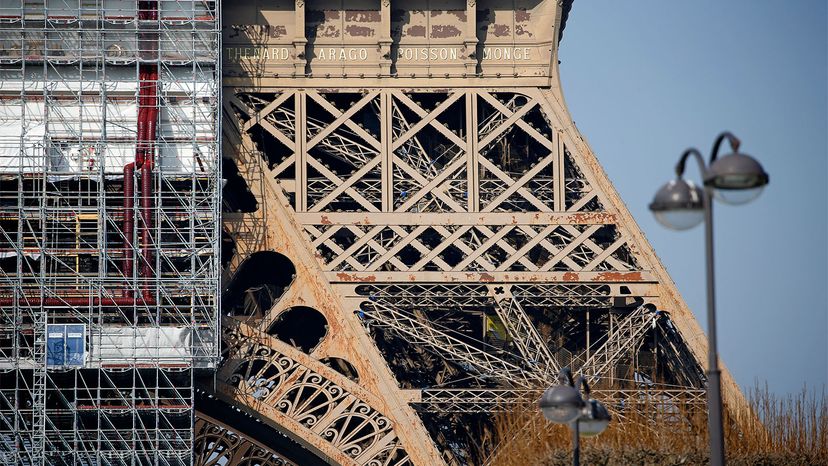
The iconic Eiffel Tower needs help.
To get it ready for the 2024 Paris Olympic Games, a $60 million (50 million euro) renovation project was launched, according to France 24 . But there have been questions about whether the efforts will be enough.
Relying on confidential reports, a 2022 article in Marianne contended that the Eiffel Tower is in a terrible state, and its planned maintenance leaves much to be desired. Although it needs "full repair," cites The Guardian , "it is being given only a cosmetic makeover" for the Olympics.
So, when was the Eiffel Tower built , and how often does it need maintenance? Learn more about the tower’s construction and what makes this structure so unique.
When Was the Eiffel Tower Built?
Construction of the eiffel tower, maintaining a metal structure, eiffel tower upkeep.
Construction of the Eiffel Tower began in 1887 and took just two years, two months and five days. The "300-meter Tower," as it was known then, opened on May 15, 1889, at the Exposition Universelle , or Paris World's Fair.
The 1889 World’s Fair happened to commemorate the centennial of the French Revolution — that makes the Tour Eiffel 100 years younger than the French Revolution .
Although many important figures in the arts and literature, such as Charles Garnier and Guy de Maupassant, protested its construction, the tower was a success, welcoming more than 2 million visitors in its first year. Today, that number is around 7 million a year, making " la dame de fer " (the “iron lady”) the world's most-visited paid monument.
The puddle iron structure at one end of the Champ de Mars was the world's tallest structure until the completion of the Chrysler Building in 1929. (At its construction, the Eiffel Tower surpassed the previous tallest building, the Washington Monument.)
Although it looks graceful in photos, up close, the Eiffel Tower is most notable for its massiveness. It stands 984 feet (300 meters) high — plus a bit extra if you count toppers like flagpoles and antennae — and sits on a base measuring 410 feet (125 meters) in width. Its metal frame weighs 7,300 tons (6,622 metric tons).
The shape of the iron tower is magical, according to Benjamin Schafer , a professor of civil and systems engineering at Johns Hopkins University.
"It's essentially the perfect shape for resisting wind load," he says.
The tower was meant to stand for only 20 years. But it turned out to be handy for radio and telecommunications transmissions, and of course, people worldwide wanted to visit. "Since the 1980s, the monument has been regularly renovated, restored and adapted for an ever-growing public," according to the Eiffel Tower website .
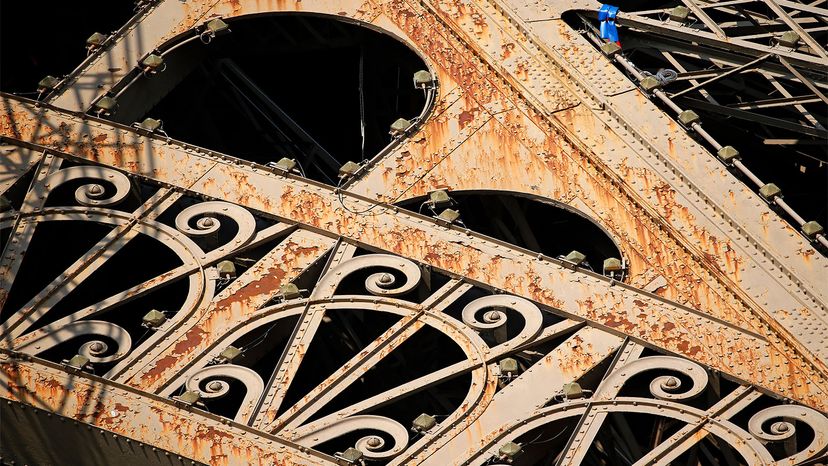
Following its first in-situ paint job in 1889, the tower has undergone several color changes.
Originally, the parts were painted Venetian red, while subsequent coats of paint have included reddish-brown, ochre brown, yellow-brown and brownish-red. In 1899, the tower had a five-hue golden gradient from yellow-orange at the base to light yellow at the top.
Since 1968, it has been 'Eiffel Tower brown' in three shades, with the darkest at the bottom. If that palette sounds dull, it was "chosen for its harmony with the Parisian cityscape," according to the website , but it will be painted a golden hue in time for the 2024 Paris Olympic Games.
According to the official Eiffel Tower website , it gets a complete paint job every seven years, a frequency recommended by Gustave Eiffel himself, and a course of action said to give it eternal life. The process consists of stripping, cleaning, applying rust-proofing and then painting the tower.
Eiffel's tower, conceived by two engineers from Gustave Eiffel's firm, Émile Nouguier and Maurice Koechlin, working with architect Stephen Sauvestre, was the winning design of an open competition for the World's Fair being planned in Paris.
Writing in Structure magazine , Roumen V. Mladjov stated in 2014 that it "is the materialized symbol of progress during the Industrial Revolution of the 19th century."
Despite its 19th-century trailblazing, the tower was constructed of iron, not steel, which would become a predominant building material shortly afterward with the birth of the modern skyscraper.
"It was built out of the only material that could have built that form at that time," says Schafer. "Corrosion and fatigue are the two big things we worry about for maintenance." Luckily, corrosion, a chemical reaction requiring oxygen and moisture, is a slow process, and like steel, iron can be protected from it by a barrier. That barrier is paint.
Gustave Eiffel knew plenty about metal structures and how to make them long-lasting — he had been building iron bridges for nearly three decades by the time the construction of the tower began. And the design of the tower has a lot in common with an arched iron bridge. Take a look at the Ponte Maria Pia that crosses the River Douro in Porto, Portugal, and you'll see a lot of similarities. Eiffel was the architect of the bridge, which was built between 1876 and 1877.
Now think about bridge maintenance; for example, the Golden Gate Bridge . Its steel structure is painted continuously, but not all at once. The bridge is painted "based on priorities" determined by where corrosion is advancing.
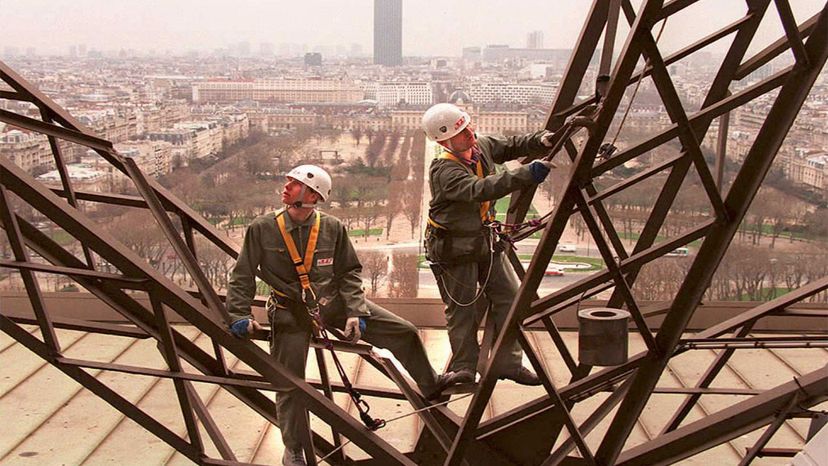
The planned renovation of the Eiffel Tower in advance of the Olympics included stripping a third of the tower and applying two new coats of paint. However, only 5 percent will now be treated because of COVID-19 delays and "the presence of worrying levels of lead in the old paint," according to The Guardian .
Furthermore, the Société d'Exploitation de la Tour Eiffel ( SETE ), the organization that operates and maintains the tower "as part of a delegated public service contract with the City of Paris," is hesitant to lose the income that a temporary closure for renovation would bring, according to The Guardian.
As cited in The Guardian , reports released from 2010 to 2016 noted issues, faults and concerns with the maintenance and condition of the Eiffel Tower. One from 2014 by paint company Expiris "found the tower had cracks and rusting and only [10 percent] of the newer paint of the tower was adhering to the structure."
When they happen, painting campaigns can take from 18 months to three years, involve about 50 painters and use 60 tons (54 metric tons) of paint, according to the tower website . Striking a balance between tourist demands and site maintenance falls on SETE. The organization set up a watchdog body to evaluate client satisfaction, and its 2019 results showed that 96 percent of visitors who responded would recommend the monument to friends or family.
"It's a continual process to keep things up," says Schafer. "The Eiffel Tower is worth maintaining because we love it."
Amateurs can feel free to snap photos of the Eiffel Tower, but nighttime pictures by professionals require authorization from SETE because the tower's sparkling lights are protected by copyright.
Please copy/paste the following text to properly cite this HowStuffWorks.com article:
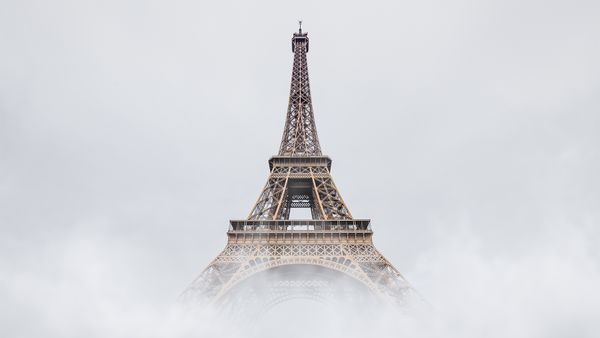

The History of the (tumultuous) construction of the Eiffel Tower
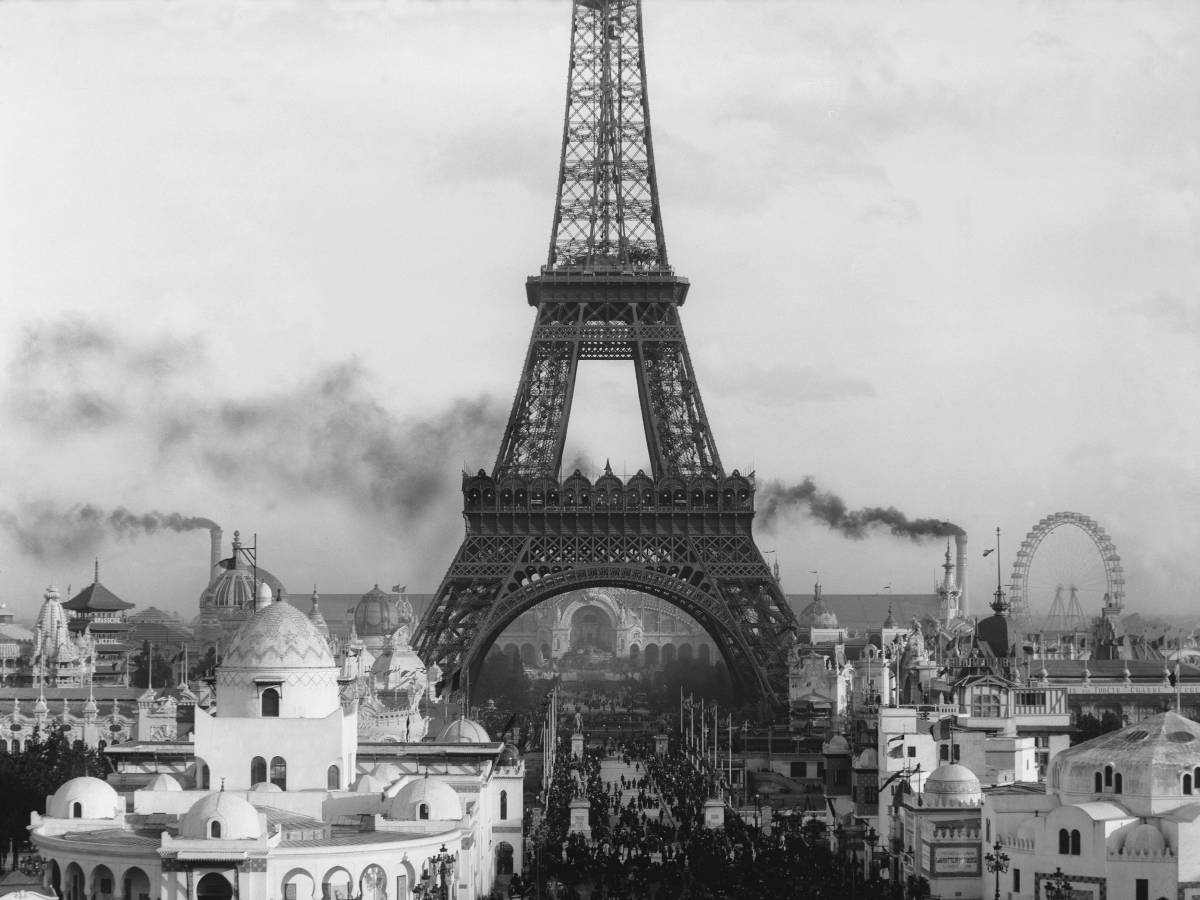
March 31, 1889, the Eiffel Tower was inaugurated after two years and two months of construction. What was the tallest building in the world had to be the leading monument of the 1889 Paris World’s Fair, which theme was the French Revolution.
A tower that should celebrate the progress of science and technology in France since 1789, but which construction set off several debates, especially from French artists and intellectuals who published articles and pamphlets against this “Tower of Babel”.
First temporary, then threatened with destruction, the Eiffel Tower was however an immediate success when it opened for the 1889 World’s Fair. A monument that has been able to impose itself despite the controversy, nowadays the most famous monument in the world.
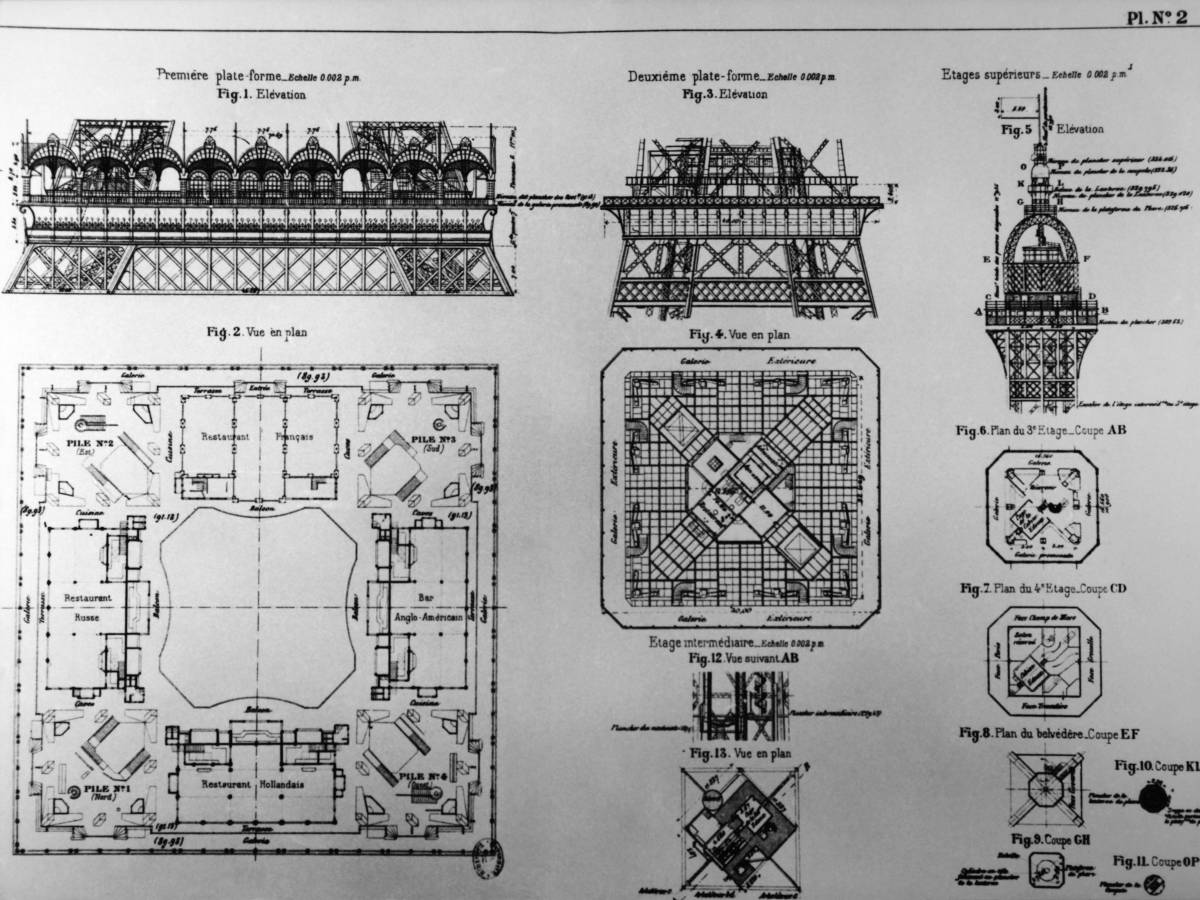
The design of the Eiffel Tower was originated by Maurice Koechlin and Emile Nouguier, two engineers working for the Eiffel Institutions Company. Initially skeptical, Gustave Eiffel bought the patent rights of the two engineers and presented his plans in 1885. A monument as a symbol of modern engineering and industrial progress throughout the 19th century.
In 1886, Gustave Eiffel finish 3rd in the competition, and signed an agreement with the government allowing him to build his tower.
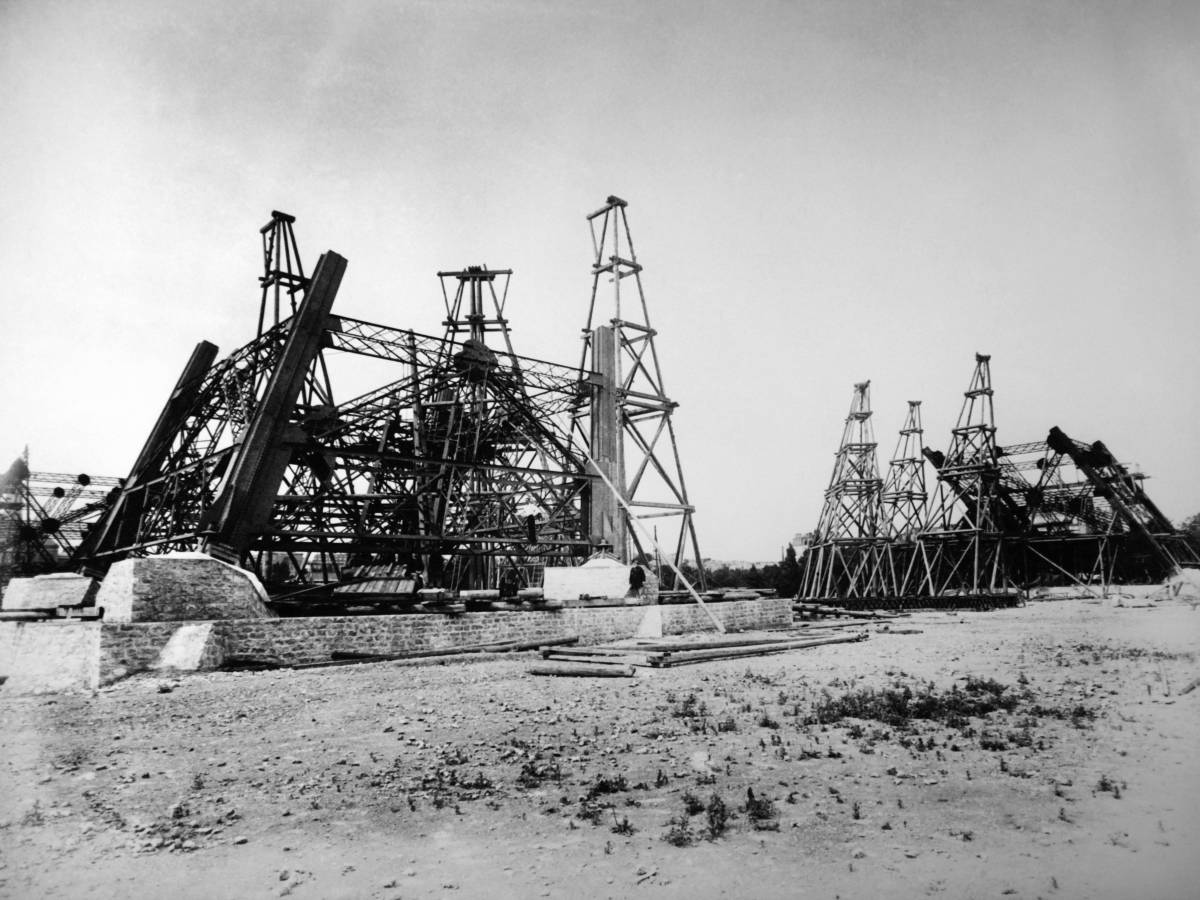
The agreement signed July 8, 1887 stipulated that from 1 January 1890, Gustave Eiffel could freely enjoy the commercial exploitation of its tower for a period of twenty years, after which the City of Paris would be the owner.
Works on the foundations began January 28, 1887.
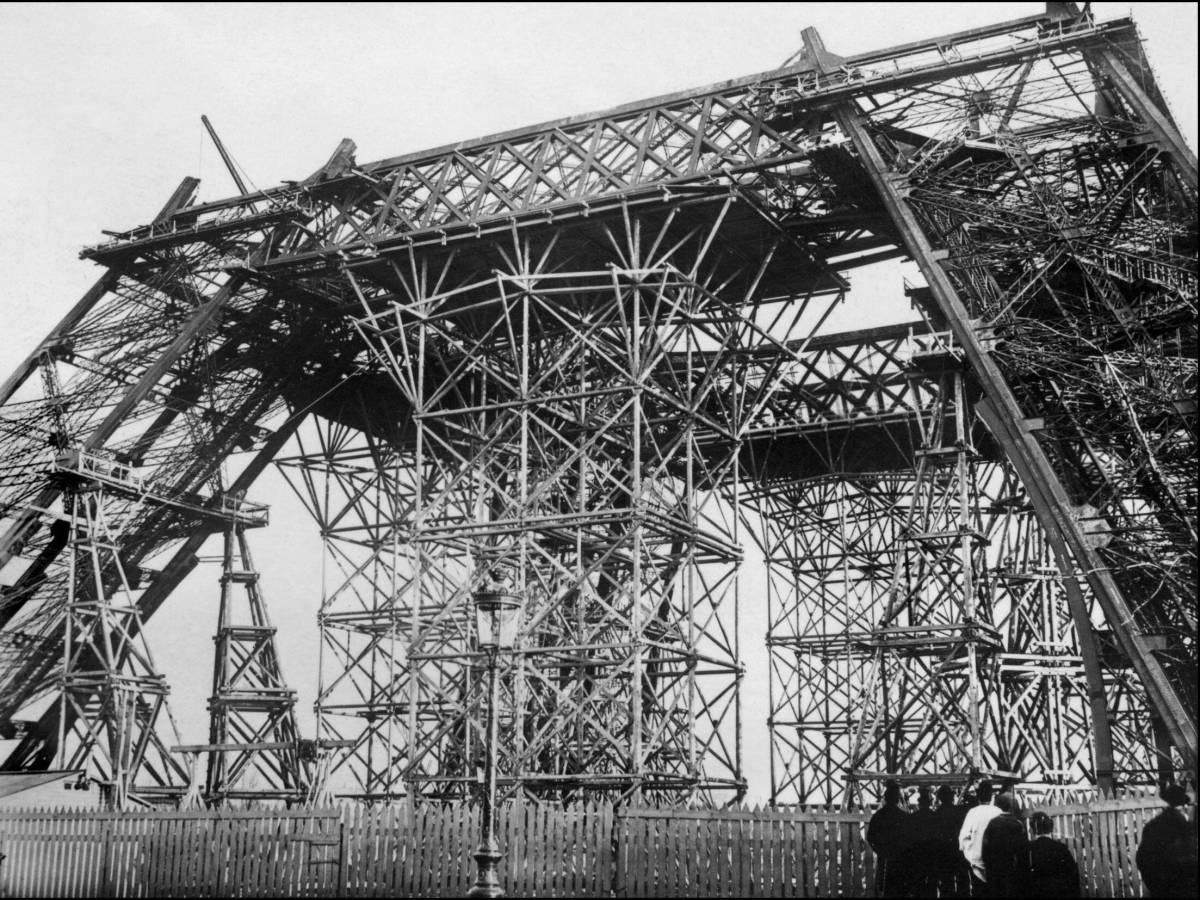
More than 300 workers were responsible for assembling the structure.
The critics
Soon, many people were questioning the aesthetic and utility of this tower, newspapers criticizing the soundness of the project. Saying such a tall monument was not possible to build, even inhabitants of the Champ de Mars gathered to bring an action against the state.
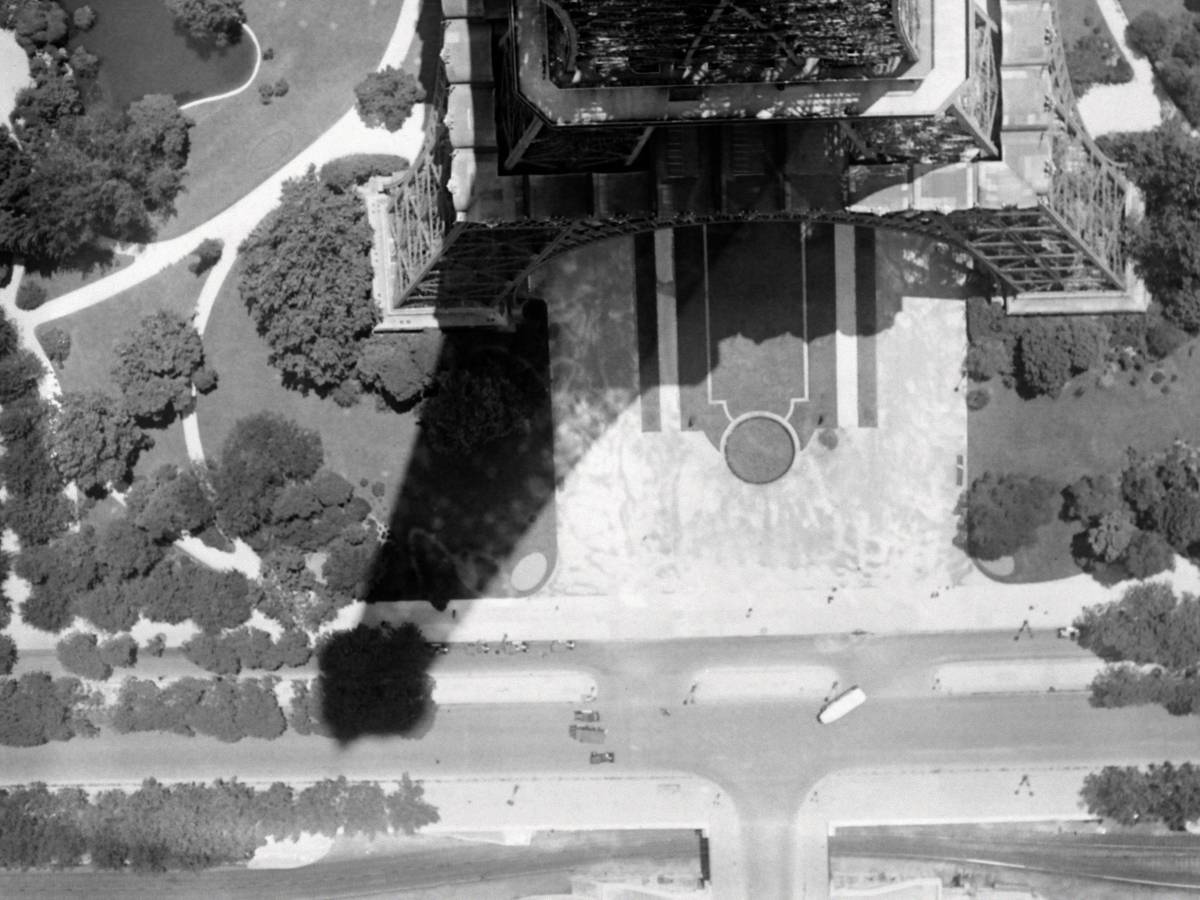
But the highlight of this critics was an open letter against the Eiffel Tower, published in the newspaper Le Temps on February 14, 1887, and signed by artistes like Joris-Karl Huysmans, Guy de Maupassant, Alexandre Dumas Fils or Charles Garnier
Read this letter (in French)

Inauguration
March 1898, the the structure was almost completed, and March 31, Gustave Eiffel inaugurated the monument by leading a group of government official and members of the press to the top of the tower. At the opening of the World’s Fair, the lifts were not working yet, what did not prevent the every-day 30 000 visitors to climb the 1,710 steps.
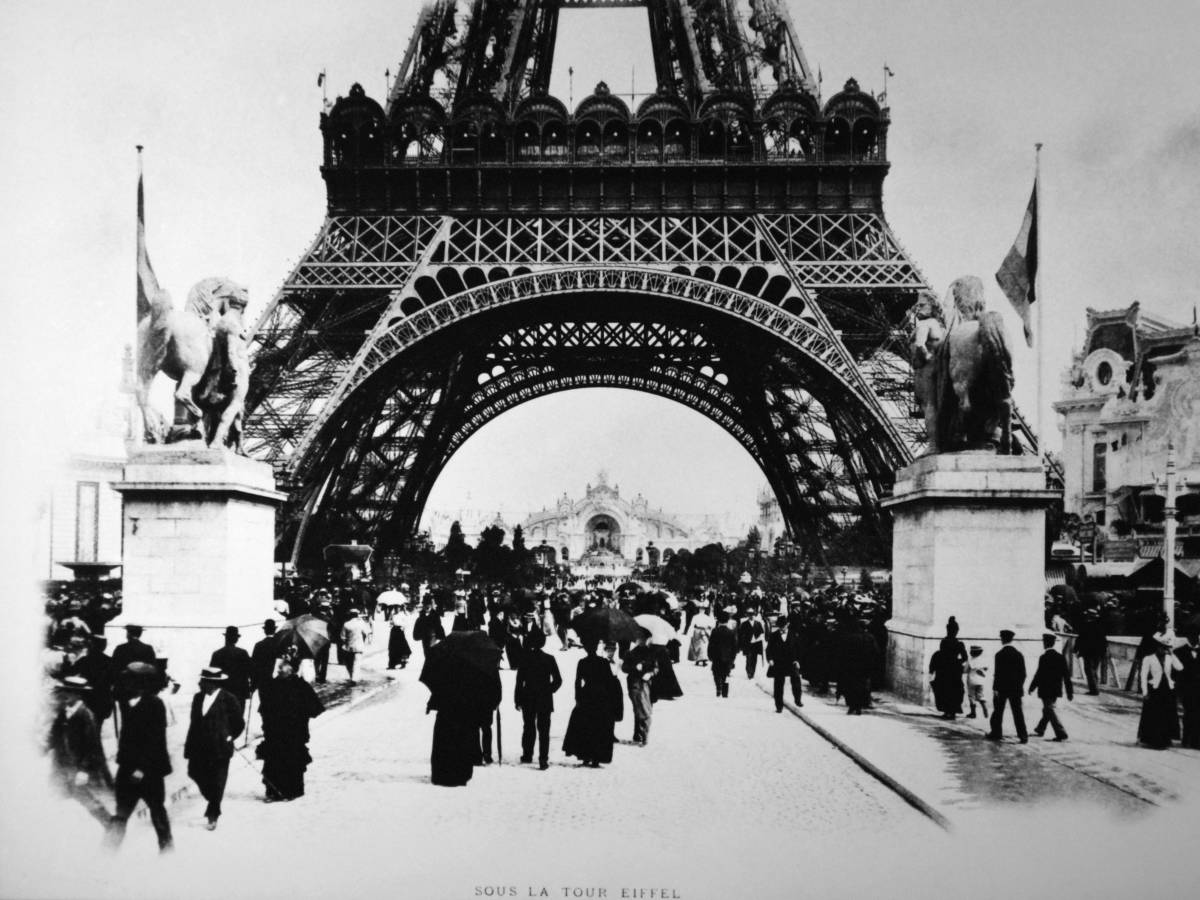
While the City of Paris became the owner of the Tower after the 20-year concession, the tower had to be destroyed. Tanks to its public success, but also to and its unique structure and height allowing scientific experiments, the destruction will be delayed.
Quickly became a symbol of Paris and France, its original critics will recognize the innovative character of the tower, and even today, the Eiffel Tower is the most visited monument in the world.

Guided Tours
Useful informations.
(Français) Rejoignez-nous sur Facebook
Related post
- Paris by night Paris by night
- Versailles Versailles
- Giverny Giverny
- France France
- Day trips from Paris Day trips from Paris
- Fooding Fooding
- Cruises Cruises
- Find your order
- Our Sanitary Program
- +33 (0)1 44 55 60 00
Choose a place
Eiffel Tower Construction : when was the eiffel tower built ?
Date and major stages of construction of the eiffel tower, when was the eiffel tower built that is the question .
The Eiffel Tower was built for the Universal Exposition of 1889, which celebrated the centennial of the French Revolution. This ambitious, controversial project later became a quintessential feature of the Parisian skyscape and a symbol of the French capital around the world. Stages of construction
The plan to build the Eiffel Tower was initially a response to a competition published in the Official Journal to prepare for the Universal Exposition of 1889. The competition called for the construction of a square iron tower to be 300 meters tall with 125-meter sides (984 feet x 410 feet). It was the highest monument in the world.
The plan proposed by Gustave Eiffel, Maurice Kœchlin and Emile Nouguier was chosen from the 107 submissions.
Here are some key dates in the construction of the Eiffel Tower:
- June 1884: The project and blueprints are finalized
- January 28, 1887: Construction work begins
- July 1, 1887: Pile assembly begins
- April 1, 1888: The first level is completed
- August 14, 1888: The second level is completed
- March 31, 1889: Assembly of the top is completed
In all, the work took two years, two months and five days and the structure was christened on March 21, 1889 . Upon completion, its design engineer Gustave Eiffel climbed the 1,710 steps of the tower to personally place a French flag at the top.
A tower built to last
Building the eiffel tower required true technical prowess.
Such a tall tower has never been built before. Indeed, standing at 984 feet high, the tower reigned for 40 years as the tallest structure in the world – until 1929. Moreover, at the time, the kind of metal structure chosen by Eiffel had only been used to build bridge piles that were far shorter. Thus the project presented a formidable architectural challenge, accompany by additional special constraints: wind resistance, project scale and the deadlines imposed by the opening date of the Universal Exposition. The endeavor seemed all the more far-fetched because of its extreme size and location right in the heart of Paris, where the tower and its 7,300 tons of iron gradually rose from the earth thanks to the labors of 300 workers perched on wood scaffolding. This utopian undertaking has become an unwavering success with the general public.
A dream fulfilled, a permanent vision
When was the Eiffel Tower built ? It's just a part of the question. The question is f or how many years was the Eiffel Tower built ? Indeed, the landmark was built for the 1889 Universal Exposition in Paris and it had been commissioned as a temporary edifice. It was slated for disassembly in spite of its incontrovertible success: during the event, two million visitors made the trip to admire its architecture and its view of Paris from above. However, it was saved by its function as an antenna: because Eiffel had been encouraged by transmission experiments from the top of the tower, it quickly became indispensable to radio transmissions and telecommunications, the real technological revolution of the coming century. Today still, in addition to its role as a tourist attraction and icon , it also works as a television antenna."

- Hispanoamérica
- Work at ArchDaily
- Terms of Use
- Privacy Policy
- Cookie Policy
- Temporary Installations
AD Classics: Eiffel Tower / Gustave Eiffel

- Written by Luke Fiederer
The world had never seen anything like the graceful iron form that rose from Paris ’ Champ de Mars in the late 1880s. The “Eiffel Tower,” built as a temporary installation for the Exposition Universelle de 1889, became an immediate sensation for its unprecedented appearance and extraordinary height. It has long outlasted its intended lifespan and become not only one of Paris’ most popular landmarks, but one of the most recognizable structures in human history.

In 1884, the French government announced the planning of an international exposition to honor the hundredth anniversary of the French Revolution of 1789 – the fourteenth such fair to be held in France since the close of the 18th Century. Shortly afterward, the French civil engineer Gustave Eiffel proposed the construction of an iron tower 300 meters (984 feet) tall as a ceremonial gateway for the Exposition.[1] Similar proposals had been put forth multiple times at least since the 1830s, and in particular before the Centennial Exhibition at Philadelphia in 1876; however, these projects ultimately never came to fruition.[2]

Eiffel was well established in the field of ironworking in the mid-1880s. His firm, one of the largest in France, had designed a number of significant structures, including the internal framework for the Statue of Liberty.[3] Eiffel had also aided in the engineering of cavernous galleries and pavilions for the Expositions of 1867 and 1878. Despite this illustrious portfolio, the firm was best known for its major railway bridges, most notably the Viaduct of Garabit – then the world’s tallest bridge. It was the experience of creating these enormous wrought-iron structures in particular that would later inform the design of the Eiffel Tower.[4]

Although it was eventually named for Gustave Eiffel , the Eiffel Tower’s design was initially conceived by three of his employees. The initial sketches and calculations of the proposed tower were made by office manager Emile Nouguier and engineer Maurice Koechlin in collaboration with architect Stephen Sauvestre. Sauvestre, in particular, was responsible for many of the design elements intended to turn what was essentially an oversized bridge pylon into an aesthetically-pleasing building. These design gestures, including the arches at the base of the tower and the bulbous finial at its summit, were intended to appeal not only to the public, but to Eiffel himself.[5]

The proposed design did not initially impress Eiffel, who nonetheless applied for patents in his, Nouguier’s, and Koechlin’s names. Later in 1884, he bought the two men out and began working directly with Sauvestre to refine the tower’s aesthetics. It was this iteration of the design that the two men submitted for consideration in 1886, and which was one of the three entries chosen among 107 submissions. In the end, the designers responsible for the other two winning designs were commissioned to build other major structures for the Exposition, while Eiffel and Sauvestre emerged as the final victors in the competition for the tower.[6]

The Eiffel Tower comprises four iron lattice piers laid out in a square, rising from an initial slope of 54° and curving upward until they meet, at which point the tower rises as a single, subtly pyramidal form until the campanile at its summit. Its form was dictated primarily by concerns about wind at high altitudes, a matter which affected even the size and placement of rivet holes in the tower’s iron members.[7] Three floors are open to visitors, with the first and second levels suspended between the four piers and the third housed in the campanile, 324 meters (1063 feet) above the ground.[8] Before construction began, Eiffel calculated that the tower would weigh 6,500 metric tons and cost 3,155,000 francs; as built, the Eiffel Tower weighs 7,300 tons, and cost two and a half times as much as was expected.[9]
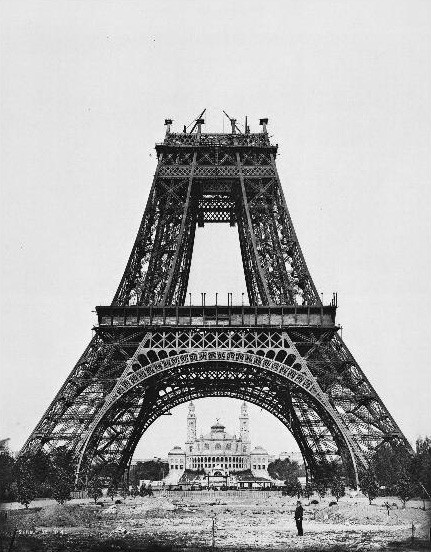
Despite its unprecedented height, the Eiffel Tower took a relatively small force of 300 workers only two years to build.[10] 18,000 pieces of ironwork were fabricated in Eiffel’s foundry in the suburb of Levallois-Perret, at which point they were transported to the Champ de Mars and lifted into place by steam cranes. Many of Sauvestre’s decorative flourishes were abandoned as the work proceeded, reducing both the construction cost and the weight of the tower. Surprisingly, there was only a single work-related fatality.[11, 12]

The growing tower provoked impassioned reactions in the Parisians who watched it rise beside the River Seine. Its wrought iron framework, seen as a symbol of the widening rift between architecture and engineering, was odious to much of the city’s artistic community. Some decried the tower as “monstrous and unnecessary,” while others compared it to a “black, gigantic factory chimney.” Its detractors included architect Charles Garnier, famed for the Opéra that bears his name, the playwright Alexandre Dumas, and writer Guy de Maupassant – the latter of whom frequently lunched at the tower in later years, as he claimed it was “the only place in Paris where I don’t have to see it.”[13, 14]

Opposition to the project proved fruitless, and Gustave Eiffel raised the French tricolor atop the completed tower in March of 1889, a full month ahead of schedule.[15] It was opened to the public two months later, drawing droves of visitors who wished to observe Paris as they never could have before. Those wishing to see an aerial view of the city ascended either by climbing one of the lengthy staircases hidden in the base pylons, or in one of a quartet of elevators designed on an articulated piston system that allowed them to follow the tower’s changing slope up to the first level. Here, visitors could take in the view from a covered arcade, as well as dine in one of four internationally-themed restaurants; the more daring could take two more sets of elevators to the second level, and subsequently to the campanile. At its opening, the system of elevators and staircases was designed to allow 5000 people to visit the Eiffel Tower each hour.[16]
.jpg?1480629521)
The Eiffel Tower soon proved to be a sensational international success. Nothing like it had ever been seen – it was twice the height of the Washington Monument, previously the tallest building in the world, and its novel method of construction only added to the effect.[17] In the 173 days the Exposition was open, over two million visitors from around the world paid to ascend its slender iron form. It made back its initial budget within a year, vindicating the financial contributions of both Eiffel and his investors. However, public interest waned quickly in the years following the Exposition; in 1890, visitorship fell to a fifth of what it had been the previous year. As the intended demolition date of 1909 loomed on the horizon, Gustave Eiffel vigorously defended the tower as uniquely valuable for the study of physics and meteorology.[18] In the debates that raged over the tower, however, it was ultimately not scientific utility that would see it preserved but its ability to be used as a radio (and later television) transmission tower.[19]
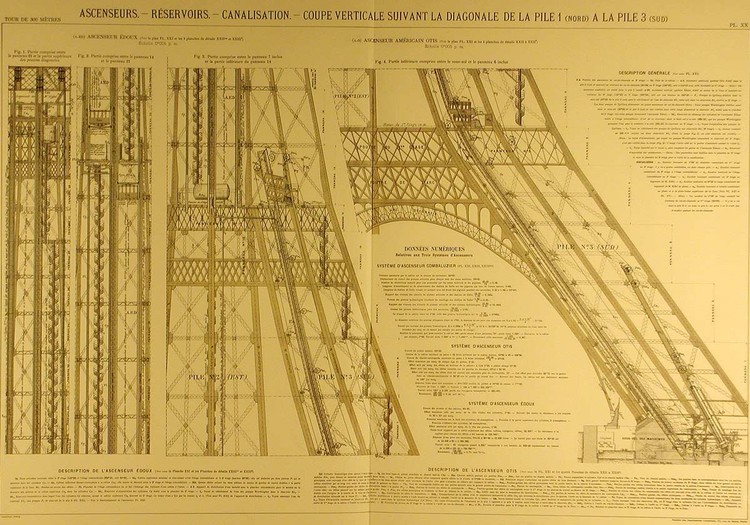
In the last century, the Eiffel Tower has come back from the brink of demolition to become one of the world’s most iconic monuments. It held the title of World’s Tallest Building for forty years, and by the time it lost that honor to New York City’s Chrysler Building, it had acquired a newer, greater significance for the people of France. The iconic nature of the Eiffel Tower has turned it into a symbol of both its nation and the city of Paris , with numerous replicas built in cities around the globe. Seven million people visit the tower every year, with much the same desire as their predecessors in 1889: to see the “City of Lights” from a stunning vista made possible by industrial innovation, nationalist fervor, and human scientific progress.[20, 21]
References [1] Tissandier, Gaston. The Eiffel Tower a Description of the Monument, Its Construction, Its Machinery, Its Object, and Its Utility. London: Sampson Low, Marston, Searle & Rivington St Dunstan's House Fetter Lane, Fleet Street, E.C., 1889. p16. [2] The Eiffel Tower: Marvels of Engineering. 2014: Marvels of Engineering. [3] Hanser, David A. Architecture of France. Westport, CT: Greenwood Press, 2006. p63-64. [4] Lemoine, Bertrand. Gustave Eiffel . Paris : F. Hazan, 1984. p126-130. [5] Hanser, p65. [6] Cowan, Henry J., and Trevor Howells. A Guide to the World's Greatest Buildings: Masterpieces of Architecture & Engineering. San Francisco, 2000: Fog City Press. p240-241. [7] Tissandier, p18-31. [8] "Key Figures: Visitors, Height, Lighting, Number of Steps, Paintwork..." La Tour Eiffel. Accessed October 11, 2016. [access] . [9] Hanser, p66. [10] Cowan and Howells, p240. [11] Hanser, p66. [12] Ayers, Andrew. The Architecture of Paris: An Architectural Guide. Stuttgart: Edition Axel Menges, 2004. p139. [13] Cowan and Howells, p241. [14] Hanser, p66-67. [15] Ayers, p139. [16] Tissandier, p69-81. [17] Tissandier, p16. [18] Hanser, p66-67. [19] Cowan and Howells, p241. [20] "Key Figures: Visitors, Height, Lighting, Number of Steps, Paintwork..." [21] "The Eiffel Tower in the World." La Tour Eiffel. Accessed October 11, 2016. [access] .
- Architects: Gustave Eiffel
- Area Area of this architecture project Area: 15625 m²
- Year Completion year of this architecture project Year: 1889
- Photographs Photographs: Wikimedia user Jebulon (Public Domain) , Jean-Pierre Dalbéra (licensed under CC BY 2.0)
Project gallery

Project location
Address: champ de mars, 5 avenue anatole france, 75007 paris, france.

- Sustainability
想阅读文章的中文版本吗?

AD经典:埃菲尔铁塔/古斯塔夫•埃菲尔
You've started following your first account, did you know.
You'll now receive updates based on what you follow! Personalize your stream and start following your favorite authors, offices and users.
Check the latest Counters
Check the latest Chairs
La construction de la tour Eiffel
Discover how the eiffel tower was built, tour eiffel.
Le chantier commence le 26 janvier 1887 avec le creusement des fondations qui seront réalisées en 4 mois.
Travaux de construction de la tour Eiffel - Poutrelles de base d'un pilier - Juillet 1887 par © Parisienne de photographie - Jacques Boyer / Roger-Viollet Tour Eiffel
Le montage des piles débute le 1er juillet 1887 pour s'achever vingt-et-un mois plus tard.
Tous les éléments sont préparés à l'usine de Levallois-Perret à côté de Paris, siège de l'entreprise Eiffel. Chacune des 18 000 pièces de la Tour est dessinée et calculée avant d'être tracée au dixième de millimètre et assemblée par éléments de cinq mètres environ.
Sur le site, entre 150 et 300 ouvriers, encadrés par une équipe de vétérans des grands viaducs métalliques, s'occupent du montage de ce gigantesque meccano.
La tour Eiffel - Un poste de riveurs par © Collection tour Eiffel Tour Eiffel
Toutes les pièces métalliques de la Tour sont fixées par des rivets, un mode de construction bien rôdé à l'époque de la construction de la Tour.
Les assemblages sont d'abord réalisés sur place par des boulons provisoires, remplacés au fur et à mesure par des rivets posés à chaud. En se refroidissant, ils se contractent, ce qui assure le serrage des pièces les unes avec les autres.
Il faut une équipe de quatre hommes pour poser un rivet : un pour le chauffer, un pour le tenir en place, un pour former la tête, un dernier pour achever l'écrasement à coups de masse. Un tiers seulement des 2 500 000 rivets que comprend la Tour ont été directement posés sur le site.
La Tour est montée à l'aide d'échafaudages en bois et de petites grues à vapeur fixées sur la Tour elle-même. Photographie prise en janvier 1888.
Le montage du premier étage est réalisé à l'aide de douze échafaudages provisoires en bois de 30 mètres de hauteur, puis de quatre grands échafaudages de 45 mètres.
Arrivée au deuxième étage - Juin 1888
Au-dessus du deuxième étage - Septembre 1888
Au-dessus de l'étage intermédiaire - Décembre 1888
Boulonnage du joint de deux arbalétriers (L'Exposition de Paris) par © Collection tour Eiffel Tour Eiffel
Le journaliste Émile Goudeau visitant le chantier au début de 1889 en décrit ainsi le spectacle : “Une épaisse fumée de goudron et de houille prenait à la gorge, tandis qu'un bruit de ferraille rugissant sous le marteau nous assourdissait. On boulonnait ..."
"... encore par là ; des ouvriers, perchés sur une assise de quelques centimètres, frappaient à tour de rôle de leur massue en fer sur les boulons (en réalité les rivets) ; on eût dit des forgerons tranquillement occupés à rythmer des mesures sur une enclume, dans quelque forge de village ; seulement ..."
"... ceux-ci ne tapaient point de haut en bas, verticalement, mais horizontalement, et comme à chaque coup des étincelles partaient en gerbes, ces hommes noirs, grandis par la perspective du plein ciel, avaient l'air de faucher des éclairs dans les nuées.”
La tour Eiffel prise du Champ-de-Mars - Exposition universelle de 1889 par © Parisienne de photographie - Neurdein / Roger-Viollet Tour Eiffel
Il n'a fallu que 2 ans 2 mois et 5 jours pour construire la tour Eiffel. Commencé en janvier 1887, le chantier s'achève le 31 mars 1889.
C'est une vitesse record si l'on songe aux moyens rudimentaires de l'époque. Le montage de la Tour est une merveille de précision, comme s'accordent à le reconnaître tous les chroniqueurs de l'époque.
Gustave Eiffel est décoré de la Légion d'Honneur sur l'étroite plate-forme du sommet.
La construction en quelques chiffres: 18 038 pièces métalliques ; 5 300 dessins d’atelier ; 50 ingénieurs et dessinateurs ; 150 ouvriers dans l’usine de Levallois-Perret ; entre 150 et 300 ouvriers sur le chantier ; 2 500 000 rivets ; 7 300 tonnes de fer ; 60 tonnes de peinture.
La tour Eiffel peut maintenant se préparer à accueillir ses premiers visiteurs.
Conception—Société d'Exploitation de la Tour Eiffel
La naissance de la tour Eiffel
La tour eiffel en 1900, inauguration et premiers visiteurs de la tour eiffel.
- présentation
- documentaires
- line producer
- How we built the Moscow metro
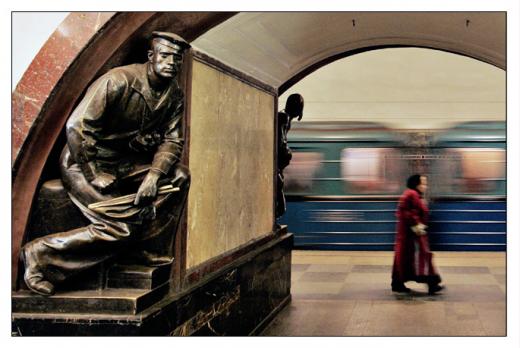
©.Mille et Une. Films, Arte France, Ethnogeographic Research Foundation
2014 • documentary • 52'
authors Anne Brunswic & Xavier Villetard • director Xavier Villetard • editing Marie-Pomme Carterert • directof of photoprahy Christopher Morley-Pegge • sound Yolande Decarsin
In the 1930’s, the workers of the underground, headed by brigades of writers, are in charge to write in real time "the history of the Moscow Metro".
Based on their narratives, partially unpublished, the film recounts the first lines construction of the most beautifiul underground in the world, in the light of this "big literary Utopia", stoped by the purges of 1937-38
A coproduction .Mille et Une. Films, Arte France & Ethnogeographic Research Foundation. With the participation of the channels Histoire and SVT.
With the support from the CNC, the region Brittany, the Procirep - Société des Producteurs and the Angoa.
International sales : Arte Distribution .

english version available
- Drumming Bones
- The Tomorrows
- The salamander complex
- With my lil' bouquet
- Struggle isn’t for everybody…
- Mikhail Gorbachev, confidential
- Danton's death
- Fragments of a revolution
- The time of the borders
- The legacy of Tibhirine
- Seven days in the life of Father Christmas
Mille et Une Films 27 avenue Louis Barthou 35000 RENNES tel : 00 33 2 23 44 03 59 [email protected]

- mentions légales & crédits
- Preplanned tours
- Daytrips out of Moscow
- Themed tours
- Customized tours
- St. Petersburg
Moscow Metro
The Moscow Metro Tour is included in most guided tours’ itineraries. Opened in 1935, under Stalin’s regime, the metro was not only meant to solve transport problems, but also was hailed as “a people’s palace”. Every station you will see during your Moscow metro tour looks like a palace room. There are bright paintings, mosaics, stained glass, bronze statues… Our Moscow metro tour includes the most impressive stations best architects and designers worked at - Ploshchad Revolutsii, Mayakovskaya, Komsomolskaya, Kievskaya, Novoslobodskaya and some others.
What is the kremlin in russia?
The guide will not only help you navigate the metro, but will also provide you with fascinating background tales for the images you see and a history of each station.
And there some stories to be told during the Moscow metro tour! The deepest station - Park Pobedy - is 84 metres under the ground with the world longest escalator of 140 meters. Parts of the so-called Metro-2, a secret strategic system of underground tunnels, was used for its construction.
During the Second World War the metro itself became a strategic asset: it was turned into the city's biggest bomb-shelter and one of the stations even became a library. 217 children were born here in 1941-1942! The metro is the most effective means of transport in the capital.
There are almost 200 stations 196 at the moment and trains run every 90 seconds! The guide of your Moscow metro tour can explain to you how to buy tickets and find your way if you plan to get around by yourself.
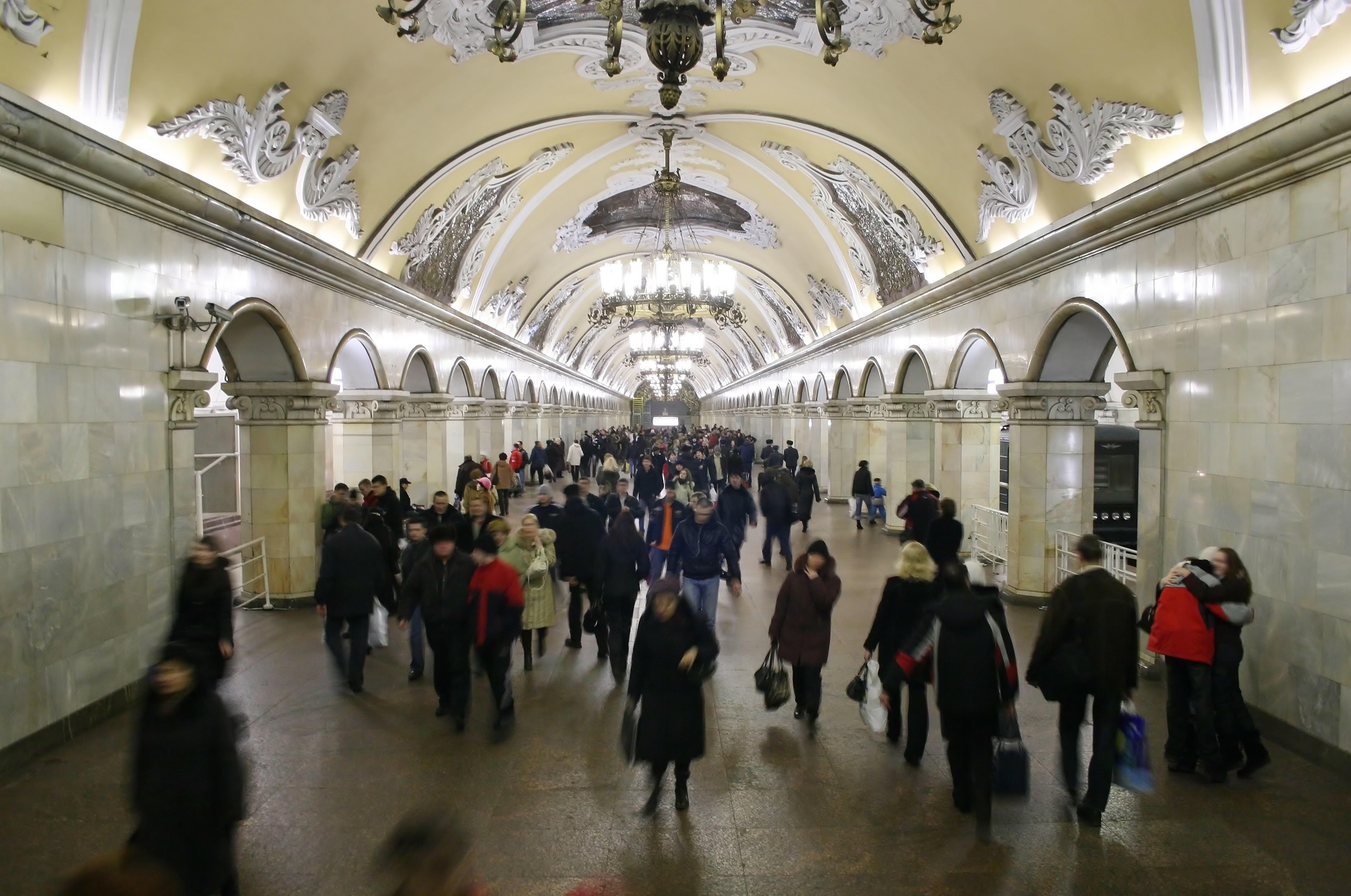
Guided Walking Tour of the Moscow Metro
Description, good to know.
- Pricing details
Departure place
You would like, admiring the frescoes in kurskaya and komsomolskaya metro stations, marvelling at the architecture of the moscow metro, listening to your guide's commentary, essential information *, duration 1 hour 50 minutes, starting time 2:00 pm.
Set off to discover the most breathtaking stops on Moscow’s beautiful metro system on this walking tour.
Some of the stops on the Moscow metro are real masterpieces. Head underground and admire the Moscow metro with your guide.
During your guided tour, you will get to admire the Ploshchad Revolyutsii , designed by the architect Dushkin. There are no fewer than 72 sculptures in this station!
You will then explore Kurskaya station, built in 1938. The design, mosaics and slogans will immerse you in the era of Stalin. You will also see the frescoes depicting Russian victories in Komsomolskaya station.
Then, continue to one of Moscow’s must-see metro stations, Novoslobodskaya , which resembles an underground palace: marble, stained glass windows...
Join your guide to explore the most lavish and important metro stops in Moscow!
- Availability: every day (excluding exceptional dates)
- Duration: 1 hr. 50 mins approx.
- Departure point: The Kremlin
- Languages: English
- Please wear comfortable shoes
- Metro tickets are included for the metro stations visited during the activity
- A valid student card will be requested from participants who have booked the reduced student tariff
- A minimum of 2 participants is required to book this activity
Price includes
- Metro tickets
- The services of an English-speaking tour guide
- The guided tour of the Moscow metro
Price doesn’t include
- Access to stations not included in the tour
- Hotel pick-up/drop-off
- Tips (optional)
- All other extras
Customers also look
- EUR (€)
- GBP (£)
- Contact us

- Currency :
- US Dollar Euro Pound Sterling Russian Ruble Australian Dollar Canadian Dollar Swiss Franc Danish Krone Japanese Yen Norwegian Krone Swedish Krona
- Toll Free 0800 011 2023
- US and Canada United Kingdom Australia Brazil Netherlands Russia Sweden
- Tours by Region Moscow Saint Petersburg Golden Ring Lake Baikal Murmansk Siberia & Far East Sochi & Southern Russia Amsterdam Berlin Copenhagen Gdansk Georgia Helsinki Kaliningrad Kamchatka Karelia Kazan Klaipeda Nizhny Novgorod Northern Europe Oslo Perm Riga Ryazan Stockholm Tallinn Ulan-Ude Veliky Novgorod Vilnius Vladivostok Volgograd Yakutia Yekaterinburg
- Why Choose our Day Tours
- One Day Tours Two Days Tours Three Day Tours
- About Russian tours Private vs Group Tours
- Tours by Region Moscow & St.Peterburg Moscow Saint Petersburg Golden Ring Lake Baikal Trans-Siberian Siberia & Far East Altai Kaliningrad Kamchatka Karelia Kazan Perm Veliky Novgorod Yakutia Yekaterinburg
- Tour Types Small Group Tours Private Tour Theme Tour
- Moscow events St. Petersburg events Events archive
- Events by type Ballet Opera Concert Show All types
- Top theaters Bolshoi theatre - Historic Stage Bolshoi theatre - Small Stage Mariinsky Theater Mariinsky Theatre - Mariinsky II Mikhailovsky Theater
- Direction Moscow - St.Petersburg St. Petersburg - Moscow
- Ships MS Rostropovich MS Volga Dream MS Anton Chekhov MS General Lavrinenkov MS Georgy Chicherin MS Ivan Bunin MS Konstantin Fedin MS Konstantin Korotkov MS Kronshtadt MS Maxim Gorky MS Nikolay Chernyshevsky MS Nizhny Novgorod MS Rachmaninoff MS River Victoria MS Scenic Tsar MS Tikhy Don (MS Alexander Borodin) MS Vasiliy Kandinsky MS Zosima Shashkov Mustai Karim
- Russian Visa Invitation
- Moscow The Kremlin Red Square Golden Ring Tverskaya Street Grand Kremlin Palace (The Kremlin) Christ the Savior Novodevichiy Convent Moscow Subway The Bolshoi Theater Armoury Chamber (The Kremlin) St. Basil's Cathedral The Pushkin Museum of Fine Arts Yury Gagarin Cosmonauts training center
- Saint Petersburg Hermitage Museum Peterhof Catherine's Palace (Tsarskoe Selo) Pavlovsk St. Isaac Cathedral Peter and Paul Fortress Nevsky Prospect Yusupov Palace Savior on Blood Amber room Bronze Horseman (Senate square) Hermitage Theatre Kazansky Cathedral Kronstadt Palace Square Spit of the Vasilievsky Island
- 1/7th of the World Volga River Siberia Baikal Kazan Sochi Smolensk Nizhny Novgorod Kaliningrad Ulyanovsk Verkhoturova Island
- uVisitRussia Why travel with UVisitRussia Customers' Testimonials Contact details Cancellations & Changes
- Russian Travel News
- Russian travel advice Advices while packing Advices while travelling
Tour of famous Moscow Metro. Explore the Underground World! (2 hours)
- Add to wishlist
On this tour you take in some of Moscow's most important and highly decorated stations. Carrying up to 7 million passengers a day and covering almost the entire city, the Moscow Metro is one of the most extensive mass transit systems in the world. It's famous for the fine examples of social-realism which decorate many of its stations.
Visit some of the most important stations and get the chance to admire spectacular baroque-style ceilings, marble statues, busts of Communist heroes, stained glass windows, and ceiling mosaics depicting the bright Soviet future. Visit the most remarkable stations like Komsomolskaya, Kurskaya, Kievskaya and others, with the experienced guide who will bring you a full insight into their fascinating history.
- Tour of Moscow's Metro system visiting beautifully decorated key stations on the network.
- System that carries more than 7 million passengers per day
- Views of the most opulently designed tunnels & platforms
- Significance to the country—known as the “People's Palace”
- History & stories relayed by an expert local guide
If you wonder why the Moscow metro is considered one the most beautiful in the world, this tour is made for you!
Important info
Ask a travel expert.
- Professional English-speaking guide assistance. Other languages upon request (additional charge may apply)
- Hotel pick-up and drop-off
- Personal expenses
- Gratuities (optional)
- Food and drinks
- Confirmation will be received at time of booking
- Children must be accompanied by an adult
Departure and return point: nearest metro station to your central Moscow hotel
Departure time: flexible
Sights included in program
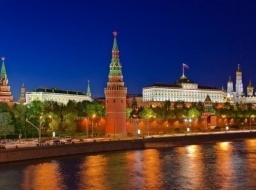
Thanks ! We will reply you in less than 24 hours (usually within 1-2 hours) .
Our flexible payment options allow you to pay 20% of a deposit first and the remaining 80% in 14 days prior to your tour date - payment can be done both online or over the phone. This gives you the peace of mind knowing your spaces are booked on the tours and that you do not miss out on making the most of your time in Russia.
Also you get the best, top-rated and most experienced and knowledgeable hand-picked tour guide appointed on a priority basis. In our experience, exceptional travel experiences are almost always delivered by exceptional people. With that in mind, we utilize a comprehensive approach to select and employ the best tour guides only. Multilingual and well travelled, each possesses deep insight into the diverse attractions and cultural patterns throughout the region. With us guides undergo a rigorous selection process, achieving outstanding knowledge of local culture and language. Rest assured that the best tour guides only will be working on the tours to give you excellent opportunity to explore the best of the sights during both short and long-term stay in Russia.
Once you complete your reservation, we will send you a booking confirmation email. As the day of the tour approaches, our logistics team will provide you with all relevant information for your tour.
Speak to an expert Call us now
+1 (888) 845-8877
- Shore excursions
- The Best of Two Capitals Private
- The Best of Two Capitals Small Group
- The Best of Two Capitals Gold
- Russia's Ancient Kingdoms
- Cradle of Russia
- Explore Moscow
- Explore St. Petersburg
- Read Customer Testimonials
- Advantages of Traveling with Us
US office 3422 Old Capitol Trail Suite 1252 , Wilmington DE, 19808 USA. US toll-free: 1-888-845-8877 Russian office Ligovsky pr. 57, Office 19, 191040, St. Petersburg, Russia
tel: +7-812-309-5339
© 2001 – 2024 by Northern Crown, Ltd. uVisitRussia and uVisitRussia.com are registered trademarks . Terms & Conditions Privacy Policy
Sign in with your social account

Sign in to our website using your Facebook or Google+ account.
Why Do You Need Our Travel Expert
Contact our experts, and they will help you to plan your best trip to Russia, with attention to every detail!
Our Experts have been in the travel industry for many years, guarantee to offer first class customer service, excellent value for money and unbiased advice. They are standing by to find and build your dream holiday to one of the world's most fascinating destinations - Russia. Your personal Travel Expert will guide you through each stage of the travel process, from choosing a program that fits you best to support during your trip.
Just tell us your e-mail, and we'll take care of everything!
Leave your phone number
Your tour request has been received. Thank you ! We have sent you the confirmation message to [email]
Please make sure that you receive this message (sometimes e-mail messages may go to the spam/junk mail). If you did not get this message, it means you will not get message with the tours' selection as well. If you use a Yahoo!, Gmail, AOL or Hotmail, we recommend to add [email protected] to your address book.
We recommend to leave your phone number. If we will not heard back that you received the e-mail with the tours' selection, we will contact you by phone. And you will not miss the best tour for you.
Thank you ! Your request for Travel Expert assistance has been sent. We will e-mail you within 1 hour.
Sorry, some changes needed
There was a problem with your request.

Major work to maintain the Tower for the future
The Eiffel Tower is undergoing the biggest works campaign in 40 years. Here we focus on the three major projects underway, coordinated by SETE.

The Eiffel Tower’s access paths are getting a makeover!

The Eiffel Tower is renovating the North pillar elevator

Dining at the Eiffel Tower: the challenge of French excellence!

Discover the new Eiffel Tower gardens

Gardens and glass wall: the new perimeter is unveiled

International projects call to redesign the Eiffel Tower Area

Everything you need to know about the Eiffel Tower at night

A mobile tour guide to discover the Eiffel Tower !

What to see around the Eiffel Tower ?

Improving accessibility for visitors of the Eiffel Tower
Eiffel Tower to undergo a major modernisation process
The lower second floor gets a makeover

A protective barrier integrated into the historic site

Beacon turned off due to maintenance works until October 10th
- Prices & Times
- Haut de page

IMAGES
COMMENTS
Découvrez comment la tour Eiffel a été construite en deux ans et deux mois pour l'Exposition universelle de 1889. Retrouvez les dates clés, les inventions techniques et les anecdotes de ce monument emblématique.
Champ-de-Mars en 1887, avant la construction de la Tour Eiffel. Photographie par Pierre Petit, musée d'Orsay. ... Elle date de l'époque de la création de la tour en 1887. Elle servait à alimenter en énergie le chantier du pilier sud durant sa construction. Victor Lustig : « l'homme qui vendit la tour Eiffel » ...
The Eiffel Tower (/ ˈ aɪ f əl / EYE-fəl; French: Tour Eiffel [tuʁ ɛfɛl] ⓘ) is a wrought-iron lattice tower on the Champ de Mars in Paris, France.It is named after the engineer Gustave Eiffel, whose company designed and built the tower from 1887 to 1889.. Locally nicknamed "La dame de fer" (French for "Iron Lady"), it was constructed as the centerpiece of the 1889 World's Fair, and to ...
It was designed and built (1887-89) by Gustave Eiffel and named in his honor. Quick facts. Designer: Gustave Eiffel. Built: 1887-89. Height: 330 meters (1,083 feet)
It took just two years, two months and five days to build the Eiffel Tower. Construction work began in January 1887 and was finished on 31 March 1889. A record speed considering the rudimentary ...
Designed by Gustave Eiffel, and unveiled during the Paris World Fair in 1889, the tower was once the tallest monument in the world, and it showcased Paris as a world-leading center for cutting-edge technology and design. The 300-metre-high tower took 2 years, 2 months and 5 days to complete, and involved some 300 on-site workers to carry out ...
By Bertrand Lemoine. From the agreed upon principle of a Universal Exhibition for 1889 and the idea of a 1,000-foot (300-meter) tower accepted at the end of 1884, Gustave Eiffel had the project studied in detail by his colleagues. When a competition for ideas was launched on May 1, 1886 for the major buildings of the Exhibition, his project was ...
Construction of the Eiffel Tower began in 1887 and took just two years, two months and five days. The "300-meter Tower," as it was known then, opened on May 15, 1889, at the Exposition Universelle, or Paris World's Fair. The 1889 World's Fair happened to commemorate the centennial of the French Revolution — that makes the Tour Eiffel 100 ...
March 1898, the the structure was almost completed, and March 31, Gustave Eiffel inaugurated the monument by leading a group of government official and members of the press to the top of the tower. At the opening of the World's Fair, the lifts were not working yet, what did not prevent the every-day 30 000 visitors to climb the 1,710 steps.
Here are some key dates in the construction of the Eiffel Tower: June 1884: The project and blueprints are finalized. January 28, 1887: Construction work begins. July 1, 1887: Pile assembly begins. April 1, 1888: The first level is completed. August 14, 1888: The second level is completed. March 31, 1889: Assembly of the top is completed.
Eiffel agreed to build upon their vision. He worked with architect Stephen Sauvetre, civil engineer Émile Nouguier, and structural engineer Maurice Koechlin to envision a three-leveled, 1,063-foot (or 300 meters) tower made of wrought iron. In addition to showcasing his engineering skills, Eiffel intended to commemorate the French Revolution ...
Périodes de conception et de construction de la tour Eiffel (avant le 31 mars 1889) Le projet d'une tour de trois cents mètres. La tour Eiffel a été construite le 28 janvier 1887 pour l'exposition universelle de Paris de 1889 pour démontrer la puissance industrielle de la France. Elle ne devait rester que 20 ans. Finalement, elle est restée et est devenue le symbole permanent de Paris et ...
Before construction began, Eiffel calculated that the tower would weigh 6,500 metric tons and cost 3,155,000 francs; as built, the Eiffel Tower weighs 7,300 tons, and cost two and a half times as ...
Il n'a fallu que 2 ans 2 mois et 5 jours pour construire la tour Eiffel. Commencé en janvier 1887, le chantier s'achève le 31 mars 1889. C'est une vitesse record si l'on songe aux moyens rudimentaires de l'époque. Le montage de la Tour est une merveille de précision, comme s'accordent à le reconnaître tous les chroniqueurs de l'époque.
The Eiffel Tower was built by Gustave Eiffel for the 1889 Exposition Universelle, which was to celebrate the 100th year anniversary of the French Revolution. Two years, two months and five days Its construction in 2 years, 2 months and 5 days was a veritable technical and architectural achievement.
La Tour Eiffel - Paris - FranceC'est à l'occasion de l'Exposition Universelle de 1889, date qui marquait le centenaire de la Révolution française qu'un gran...
Based on their narratives, partially unpublished, the film recounts the first lines construction of the most beautifiul underground in the world, in the light of this "big literary Utopia", stoped by the purges of 1937-38 . A coproduction .Mille et Une. Films, Arte France & Ethnogeographic Research Foundation.
The Moscow Metro Tour is included in most guided tours' itineraries. Opened in 1935, under Stalin's regime, the metro was not only meant to solve transport problems, but also was hailed as "a people's palace". ... Parts of the so-called Metro-2, a secret strategic system of underground tunnels, was used for its construction.
Set off to discover the most breathtaking stops on Moscow's beautiful metro system on this walking tour. Some of the stops on the Moscow metro are real masterpieces. Head underground and admire the Moscow metro with your guide. During your guided tour, you will get to admire the Ploshchad Revolyutsii, designed by the architect Dushkin. There ...
Le secret de la Tour : la préfabrication. Le 1er juillet 1887, le montage de la partie métallique peut commencer. Le temps d'incubation du projet a été mis à profit : le projet est au point, les dimensions des 18 000 pièces qui constituent la tour précisément calculées puis dessinées, avec 700 dessins d'ingénieur et 3600 plans d ...
Toll Free 0800 011 2023 ... Day tours. Tours by Region
Eiffel Tower to undergo a major modernisation process. From September 2017, the Eiffel Tower will undergo renovation work and the modernisation of its visitor reception. 300 million euros will be dedicated towards improving and renovating the Eiffel Tower, ensuring the longevity of this most famous of Paris monuments. Works.